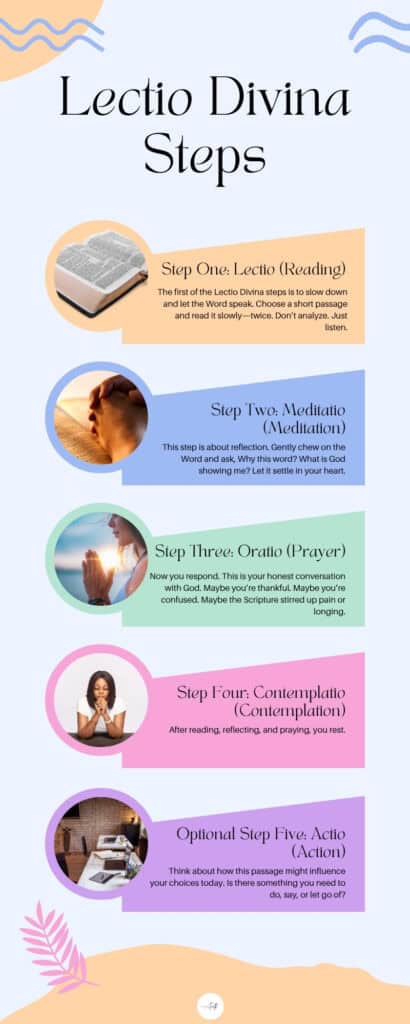Lectio Divina Steps: Complete Guide to the Ancient Practice of Spiritual Reading
Please note that this article may contain affiliate links. As an Amazon Associate, I earn on qualifying purchases at no additional cost to you. You can read more at the bottom of this page or read my full disclosure on my Affiliate Disclosure Page
You open your Bible, hoping to find peace, but instead, your mind stays cluttered and your heart feels far away. You want more than just reading the words. You want connection. You want calm. The problem isn’t your desire. It’s the noise around you and the rush inside you.
That’s where the Lectio Divina steps come in. This ancient practice isn’t about checking off a reading plan. It’s a quiet, soul-centered way to slow down and hear God speak through His Word. If you’ve been longing to experience Scripture on a deeper level, this complete guide will walk you through every step with clarity and grace.

What is Lectio Divina?
Lectio Divina is Latin for “divine reading.” It began in early Christian monasticism, where believers longed not just to study Scripture but to encounter God through it. Saint Benedict helped formalize the process in the 6th century, and it’s been practiced ever since by those who hunger for more than just knowledge. They want intimacy with God.
The difference between typical Bible study and Lectio Divina is simple: one focuses on information, the other on transformation. This method teaches you to read the Bible not just with your mind, but with your heart. You’re not just learning about God; you’re listening to Him.
Lectio Divina Meaning and Spiritual Purpose
The heart of Lectio Divina is relationship. It helps you move from simply reading Scripture to experiencing it. You stop trying to rush through a reading plan and start sitting with a passage until it speaks to you.
Lectio Divina is spiritual listening. The goal is to open your heart so God’s Word shapes you from the inside out. You let the Bible become personal, not just historical. It becomes your nourishment, your direction, your peace.
Unlike academic study, Lectio Divina invites quiet, reflection, and intimacy. It slows you down and opens space for the Holy Spirit to speak through the living Word.
The Four Traditional Lectio Divina Steps
There are four traditional Lectio Divina steps, and each one brings you deeper into connection with God:
- Lectio (Reading) – Reading the passage slowly and attentively
- Meditatio (Meditation) – Reflecting on what stands out and why
- Oratio (Prayer) – Responding to God in honest, personal prayer
- Contemplatio (Contemplation) – Resting quietly in God’s presence
Many people also add a fifth step:
- Actio (Action) – Taking what God showed you into your daily life
We’ll walk through each of these next so you can understand how to use them in your quiet time.

Step One: Lectio (Reading)
This first of the Lectio Divina steps is about slowing down and letting the Word of God wash over you. You’re not reading to analyze. You’re reading to hear. Choose a short passage. Just a few verses from a Psalm or Gospel can be plenty. Read it once slowly. Then read it again.
Let a word or phrase stand out to you. Don’t overthink it. Trust that the Spirit is drawing your attention where He wants.
Tips for sacred reading:
- Read the passage aloud if possible.
- Pause between phrases to give the words space.
- Read the same verse more than once if it feels right.
- Highlight or write down the word or phrase that tugs at your heart.
Lectio is about receiving. You’re letting the Word enter gently, not dissecting it.
Step Two: Meditatio (Meditation)
This step invites you to reflect. Think of it like chewing on the Word, savoring it slowly. Ask yourself: Why this word? What is God showing me through this? Let your mind and heart sit with it.
You might journal a few lines or questions here. This isn’t about figuring something out. It’s about letting God speak into your personal life through the passage.
Helpful reflection prompts:
- What about this word or phrase speaks to me today?
- Is there something in my life this touches?
- What emotion or memory does this stir?
Don’t worry if the answers aren’t clear right away. Stay with the Scripture. Let it shape you in the waiting.
Step Three: Oratio (Prayer)
Now you respond. This is your honest conversation with God. Maybe you’re thankful. Maybe you’re confused. Maybe the Scripture stirred up pain or longing.
Use the verse to guide your prayer. Speak from your heart. You don’t have to be polished or formal. God is listening with love.
Prayer ideas:
- Lord, thank You for showing me…
- I don’t understand, but I’m willing to hear You…
- This word reminds me of when…
This step is where Lectio Divina starts feeling deeply personal. You’re not just thinking about God. You’re talking to Him.
Step Four: Contemplatio (Contemplation)
After reading, reflecting, and praying, you rest.
This is the quietest part. You let go of words and just sit in God’s presence. You don’t have to say or think anything. Just be with Him.
This can feel awkward at first. But give it time. Contemplation is about trust. You’re trusting that God is working in you even when you’re not doing anything.
Ways to stay present:
- Sit quietly with your eyes closed for 5–10 minutes.
- Focus gently on a word like “peace” or “Jesus.”
- Picture sitting with God in a safe, quiet place.
This is the stillness that Psalm 46:10 points to: “Cease striving and know that I am God.”
Optional Step Five: Actio (Action)
This step isn’t always included, but it’s powerful. What you’ve received during Lectio Divina isn’t meant to stay in your journal. It’s meant to shape your life.
Think about how this passage might influence your choices today. Is there something you need to do, say, or let go of?
Practical actions might include:
- Reaching out to someone you’ve been avoiding
- Letting go of a grudge or habit
- Being more present or grateful in your daily tasks
Spiritual reading becomes spiritual living.
Preparing for Lectio Divina Practice
You don’t need much to get started with Lectio Divina steps, but a little intention helps.
Create a peaceful space:
- Choose a quiet time of day; morning or evening works best
- Light a candle or play soft instrumental worship
- Have your Bible, a journal, and a pen nearby
Even a small, sacred space can help you slow down and tune in.
Scripture Suggestions for Beginners
If you’re new to Lectio Divina, start with simple, heartfelt passages. Here are 10 great places to begin:
- Psalm 23:1-6
- John 15:4-5
- Romans 8:26-28
- Matthew 11:28-30
- Philippians 4:6-7
- Isaiah 43:1-2
- 1 John 4:7-11
- Psalm 46:10-11
- Luke 1:46-55
- Colossians 3:12-17
You can also rotate through Psalms, the Gospels, or epistles for daily practice.
Common Challenges and How to Overcome Them
Distraction: If your mind wanders, gently bring it back. Jot down the distractions to return to later.
Dryness: Some days may feel flat. Keep showing up. God honors your consistency.
Feeling nothing: That’s okay. Lectio Divina isn’t about emotional highs. It’s about relationship.
Even silence is part of the journey. Sometimes God is quiet so we’ll draw closer.
Lectio Divina for Groups vs Individuals
While Lectio is often personal, it can also be shared in groups.
In a group setting:
- Choose one passage for everyone
- Read it aloud slowly, twice
- Invite each person to share a word or insight
- Allow silence and space between sharings
Group Lectio builds spiritual intimacy and trust. It also helps people who are new to the practice ease into it.
Lectio Divina and Modern Spirituality
This ancient practice speaks powerfully into our rushed, noisy lives. It overlaps with practices like mindfulness, but is rooted in Scripture and the presence of God.
It’s practiced today across Catholic, Orthodox, and Protestant communities. You don’t need a degree in theology, just a willing heart.
Even studies show that meditative prayer improves peace, focus, and emotional health. But more than that, it draws you near to the heart of the Father.
Tools, Resources, and Further Reading
Books:
- Sacred Reading by Michael Casey
- Open Mind, Open Heart by Thomas Keating
- Praying Scripture for a Change by Tim Gray
Apps & Guides:
- Lectio365 (Protestant)
- Hallow (Catholic)
- Abide
- BibleProject
Other Resources and Suggestions:
- Journal what God puts on your heart
- Scripture card sets
- Weekly prayer calendars (you can find one in our exclusive Bible study for Women, True Confidence)
My Final Thoughts
The Lectio Divina steps invite you into a slower rhythm, where you don’t just read Scripture but experience it. In a world full of noise and rush, this practice makes room for peace, presence, and personal transformation.
You don’t need to master it. You just need to start. Let the Word lead you, one small step at a time.
If you’ve been longing for a deeper way to meet God in His Word, try Lectio Divina this week. And when you do, come share your experience in our She Opens the Bible Study Community Group. We’d love to hear what God is showing you.
And if this guide blessed you, leave a comment below or pass it along to a friend who might need it.
Let’s keep walking into sacred stillness together.
FAQs
-
Is Lectio Divina only for Catholics?
No. While it began in Catholic monasticism, it’s widely practiced by Christians of all traditions today.
-
Can I use any Bible passage?
Yes, though Psalms, Gospels, and letters are often easier to sit with reflectively.
-
How often should I practice Lectio Divina?
Many practice it daily or weekly. The key is consistency and quiet space.
-
What makes Lectio Divina different from Bible study?
Lectio focuses more on relationship than analysis. It’s about listening and responding to God.
-
What if I feel nothing during the practice?
That’s okay. God still works in the silence. Keep showing up and trusting the process.

About our author…
Sue Nelson is a Christian author, Bible teacher, and conference speaker with a heart for helping women grow deeper in their walk with God. She has written several books on Christian marriage, Proverbs 31 living, verse mapping, and the Twelve Tribes of Israel. Her Bible studies and devotional tools are used by women’s ministries across the United States.
With years of experience teaching Scripture and leading small groups, Sue has spoken at numerous women’s conferences and retreats nationwide. She actively serves in multiple ministries at her home church—including Hospitality, Welcome PSG Corp, and Leaders of the Pack—and is known for her willingness to serve wherever there’s a need.
A wife, mom, grandmother, and proud dog/cat mom, Sue lives a life centered on Christ. She supports a wide range of Christian causes, including Bible distribution, scholarships for faith-based retreats, homeless outreach, food pantries, and clothing ministries.
You can connect with her through her women’s Bible study community, She Opens Her Bible
NASB – “Scripture quotations taken from the NASB. Copyright by The Lockman Foundation“

